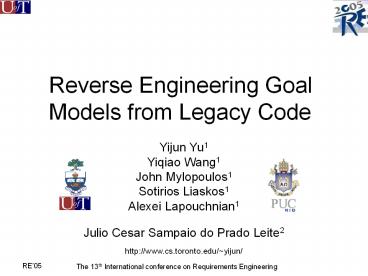Reverse Engineering Goal Models from Legacy Code - PowerPoint PPT Presentation
Title:
Reverse Engineering Goal Models from Legacy Code
Description:
Reverse Engineering Goal Models from Legacy Code Yijun Yu1 Yiqiao Wang1 John Mylopoulos1 Sotirios Liaskos1 Alexei Lapouchnian1 Julio Cesar Sampaio do Prado Leite2 – PowerPoint PPT presentation
Number of Views:172
Avg rating:3.0/5.0
Title: Reverse Engineering Goal Models from Legacy Code
1
Reverse Engineering Goal Models from Legacy Code
- Yijun Yu1
- Yiqiao Wang1
- John Mylopoulos1
- Sotirios Liaskos1
- Alexei Lapouchnian1
- Julio Cesar Sampaio do Prado Leite2
- http//www.cs.toronto.edu/yijun/
2
1. Motivation
- In legacy software, the purpose (goals,
requirements) of a software system is almost
always lost in legacy code - In the new era, open and dynamic systems require
high-variability software - So, we need to recover the purpose of the legacy
software in order to adapt it for the new context
3
Put into reengineering perspective
Horseshoe Model
abstract
Reverse engineering
Forward engineering
Requirements
IntentionsTradeoffs
GOAL MODEL
GOAL MODEL
customizablearchitecture
SOA
Architectures
BEHAVIOUR MODEL
Web services
Functions
components
LEGACY CODE
Code
time
4
Hard goal model
5
Soft goal model
6
Put into reengineering perspective
Horseshoe Model
Reverse engineering
Forward engineering
Requirements
IntentionsTradeoffs
GOAL MODEL
GOAL MODEL
customizablearchitecture
SOA
Architectures
BEHAVIOUR MODEL
Web services
Functions
components
LEGACY CODE
Code
7
2. A tool supported reverse engineering
2.1
FPT compiler
FPT compiler
2.2
2.3
2.4
2.4
8
2.1 Software Refactoring
- Software refactoring Restructuring existing
code by altering its internal structure without
changing its external behaviour - Martin
Fowler, also Comments signal the semantic gap
between the code and the programmers purpose
entry
// the following does S S1(I1, O1) S2(I2,
O2) // other
// refactored S(I, O)
exit
I Variables defined before the entry of the
block O Variables defined in the block that will
be used after the exit
9
2.2 Statecharts refactoring
- Statecharts are used to bridge the semantics
abstraction gap between source code and goal
models - refactored source code
- equivalent statechart
- higher-level statechart
- unstructured high-level program
- structured high-level program
10
2.3 Goal model from structured programs
11
2.4 Identifying NFR and softgoals
- Create a set of functional tests
- If removing a method does not break the
functional test, then the goal associated with
the method is a NFR - If the identified NFR improves some quality
attribute, then - There is a soft goal for the quality attribute
- There is a contribution from the NFR to the
softgoal
12
3. Case studies
- Case study selection criteria
- Email software systems as they are the target for
personal RE - Software popularity with a large user base, must
support wide-range of requirements - Open-source the validity of the findings can be
verified - Applicable with our tool support
13
3.1 The Columba case study
- 1 ColumbaLogger.createDefaultHandler()
- 2 registerCommandLineArguments()
- 3 // handle commandline parameters
- 4 if (handleCoreCommandLineParameters(args))
- 5 System.exit(0)
- ...
- Why Columba?
- it is an email system
- popular
- 140 KLoc
- Open-source
- Java
- Ver. 1.0RC2
- Whats New!
- Ver. 1.0RC3 has put one of our resulting NFR
into comments
1 ColumbaLogger.createDefaultHandler() 2
registerCommandLineArguments() 3
handle_commandline_parameters(args) ...
- 1 // ColumbaLogger.createDefaultHandler()
- 2 registerCommandLineArguments()
- 3 handle_commandline_parameters(args)
- ...
- boolean maintainability_logging false
- ...
- 1 if (maintainability_logging)
- 2 ColumbaLogger.createDefaultHandler()
- 3 registerCommandLineArguments()
- ...
14
(No Transcript)
15
A running Columba
16
The core functional Columba
17
JUnit testing for Preserved Functionality
18
3.2 The Squirrel Mail case study
- Why Squirrel Mail?
- it is also an email system
- popular
- PHP HTML
- 70 KLoc
- Open-source
- unstructured
- Check this
- Its reliable, secure, easy to use
- but not that fast
19
Restructure AST Goal Graph into Stakeholder Goals
20
4. Conclusion
- A reverse engineering process is proposed to
recover a goal model from legacy code. - This is a critical step in reengineering legacy
code to improve its quality through variability. - Reverse Engineering research has focused almost
exclusively on recovering design information
(rather than purposes) - Future work
- Need to further evaluate the effectiveness of
heuristics used - Need more experiments
21
Welcome to the 1st RETR workshop
- Reverse engineering to Requirements
- Collocated with WCRE05, November Pittsburg, USA
- http//www.cs.toronto.edu/km/retr































